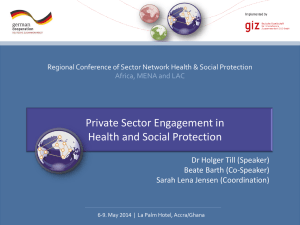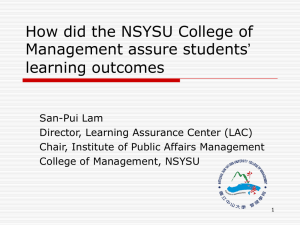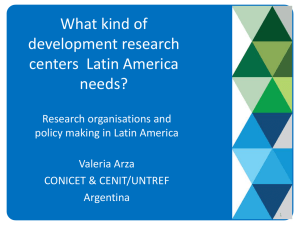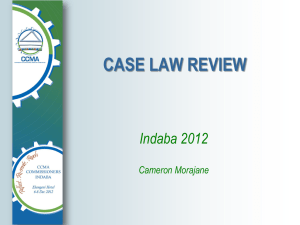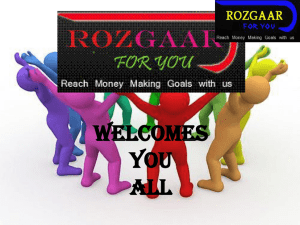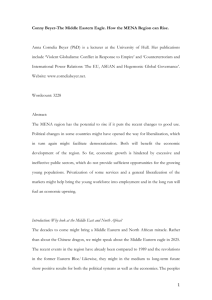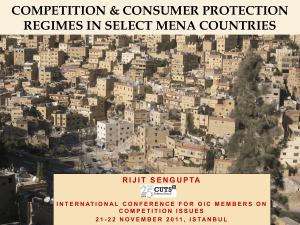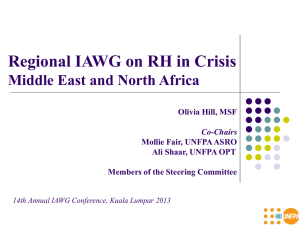Kai Straehler-Pohl - Healthy DEvelopments
advertisement
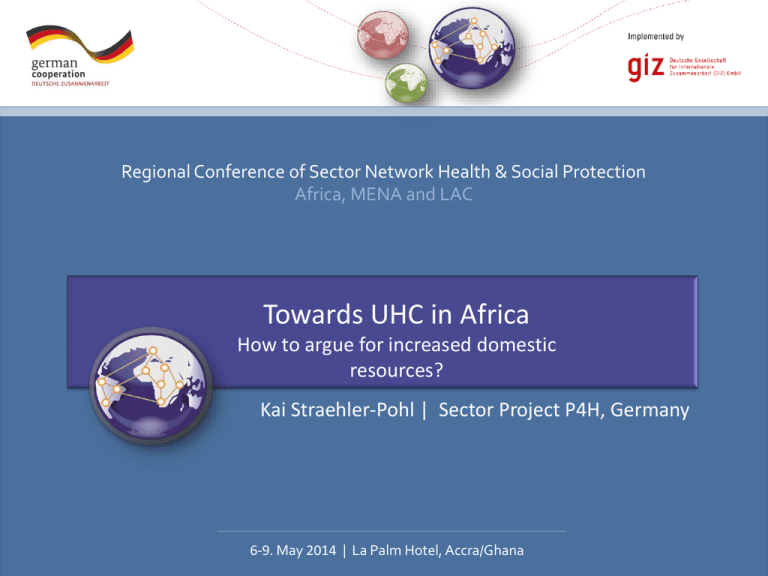
Regional Conference of Sector Network Health & Social Protection Africa, MENA and LAC Towards UHC in Africa How to argue for increased domestic resources? Kai Straehler-Pohl | Sector Project P4H, Germany 6-9. May 2014 | La Palm Hotel, Accra/Ghana Africa on the move – Countries moving towards UHC HFS/UHC/SHP Processes GIZ/P4H supported process … but one challenge remains: How to get the Ministry of Finance on board for a substial budget increase? P4H supported process Other known processes Regional Conference of Sector Network Health & Social Protection | Africa, MENA and LAC Part 1: The necessary condition Arguments that you should invest Regional Conference of Sector Network Health & Social Protection | Africa, MENA and LAC The intrinsic value: Health as a human right • "Everyone has the right to a standard of living adequate for the health and well-being of himself & of his family, including […] medical care […]." Art. 25 Universal Declaration of Human Rights, 1948 • “… the right of everyone to the enjoyment of the highest attainable standard of physical and mental health […] assure to all medical service and medical attention in the event of sickness” Art. 12 International Covenant of Economic, Social and Cultural Rights, 1966 General comment No. 14 (ECOSOC, 2000): … a set of both freedoms and entitlements which accommodate the individual's biological and social conditions as well as the State's available resources, both of which may preclude a right to be healthy for reasons beyond the influence or control of the State… Regional Conference of Sector Network Health & Social Protection | Africa, MENA and LAC The instrumental value: Health generates wealth Wordle from: Harmonization for Health in Africa (2011): Investing in Health for Africa: The Case for Strengthening Systems for Better Health Outcomes. Chapter 3 – The wider investment case. Regional Conference of Sector Network Health & Social Protection | Africa, MENA and LAC The instrumental value: Health generates wealth (2) • Health increases productive years – fewer life years lost increase life expectancy lengthens active working age 11% of L/MIC growth 1970-2000 (Jamison et al. 2005) • Health increases labour productivity – especially in manual labour in largely agricultural economies such as many African economies • Health brings investments in education – lower absence times of pupils and free funds to invest in household budgets • Health lowers dependency ratio – lower child mortality typically leads to lower birth ratios and thus higher pop share at working age • Health shifts consumption – frees up money and increases markets for other goods Regional Conference of Sector Network Health & Social Protection | Africa, MENA and LAC The instrumental value: Health generates wealth (3) • Health increases investments – people live longer, save/invest more to cater for the future, whether through social or traditional systems • Health increases ROIs – lower risk of illness allows higher risk economic investments that are typically more profitable • Health stabilizes workplaces – fewer deaths lead to lower staff turnover and increase productivity • Health can increase FDI – in some sectors some diseases (e.g. tourism and Malaria) are immediate obstacles to foreign investments Regional Conference of Sector Network Health & Social Protection | Africa, MENA and LAC Lower fertility and lower child mortality Improved child health and nutrition Increased ratio of workers to dependants Higher GDP per capita Increased labour productivity Increased school attendance and cognitive ability Adapted from: Ruger, Jamison and Bloom (2002): WG report 1 of The Commission on Macroeconomics and Health. Larger labour force from increased survival and later retirement Improved adult health and nutrition Increased access to natural resources and global economy Increased investment in physical capital Higher attractiveness for FDI Regional Conference of Sector Network Health & Social Protection | Africa, MENA and LAC The combined argument: Health is wealth • Premise: GNI/GDP is not an appropriate goal dimension • Worldwide: Human Development Index • Income, Life expectancy, education (indeces) • Bhutan: Gross Happiness Index • Economic, environmental, physical, mental, workplace, social, and political wellness – mostly measured through direct survey • World Development Report: • Disability adjusted life years (DALYs) – morbidity adjustments to life expectancy Regional Conference of Sector Network Health & Social Protection | Africa, MENA and LAC The combined argument: Health is wealth (2) • Lancet Commission Global Health 2035: “Full income” approach people value additional life year and reduced mortality risk 1 yr additional life expectancy = 2.3 annual income in L/MIC • Full income = f(economic income, mortality risk) decrease mortality risk = increase in full income • 33-50% of “full income” growth is from reduction in mortality risk • UHC with highly cost-effective interventions in 2035 = -9.3 m deaths ROI of Universal Coverage with highly cost effective interventions: 34 low income countries: 900% (~65% HSS costs) 48 middle income countries: 2,000% (~35% HSS costs) • Note: Expansion of approach to morbidity (e.g. DALYs) would increase estimated return – but reopen ethical debate on value of life Regional Conference of Sector Network Health & Social Protection | Africa, MENA and LAC Part 2: The sufficient condition Arguments that the investment will pay off Regional Conference of Sector Network Health & Social Protection | Africa, MENA and LAC The performance argument: Monitoring results • • • • Premise: Good results provide positive incentives for taking action Measure impacts/outcomes: • Health: Demographic and Health Surveys (DHS), SAGE; Downside: no political driver due to typical 5 year cycle • Financial protection: Household income/expenditure/budget surveys; downside: no political driver due to typical 5 year cycle Measure outputs: • Health: Health Management Information Systems to measure health service utilization (proxy attractiveness and access); downside: utilization can also be a sign of bad health • Finance: National Health Accounts – OOPs; downside: often not disaggregated by equity / incomes Measure inputs: • Health system: Service Availability and Readiness Assessments/Mappings • Financial: National Health accounts, Public Expenditure Reviews Regional Conference of Sector Network Health & Social Protection | Africa, MENA and LAC The value-for-money argument: Doing the right things right • Allocative efficiency reforms: • Investing in highly cost effective interventions – the benefit package design • Letting the money follow patients – payment system design (pt. 1) • Technical efficiency reforms: • Creating incentives for frugality – payment system design (pt. 2) • Allowing managers to manage – taking decisions where information on inefficiencies is • Building capacity for managers – making sure that managers are equipped to take decisions • Monitoring: Public Expenditure Tracking Surveys; Social Audits Regional Conference of Sector Network Health & Social Protection | Africa, MENA and LAC The performance argument: incentives to improve • Riding the wave – performance/results-based financing is in fashion, so use the words to promote any output-based payments systems… • Using “standard” PBF to complementing other reforms • Use to translate policy priorities into action (as with all priority setting, negative side-effects need to be monitored) • Reward process indicators where “market failures” exist (e.g. data is often only useful when aggregated, so individuals fail to provide) • Efficiency-based local savings are a good source for local incentive schemes (but only if maintenance of standards is controlled) • Reward directly your objective – staff redistribution (e.g. to rural areas) via PBF may backfire Regional Conference of Sector Network Health & Social Protection | Africa, MENA and LAC Regional Conference of Sector Network Health & Social Protection Africa, MENA and LAC THANK YOU! kai.straehler-pohl@giz.de 6-9. May 2014 | La Palm Hotel, Accra/Ghana

